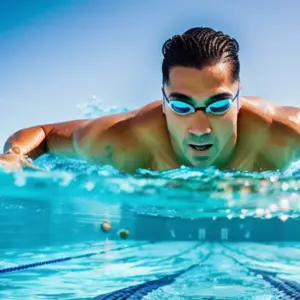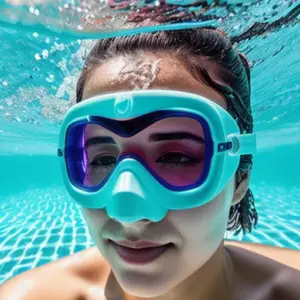Picture yourself diving into the crystal-clear waters of a tropical paradise, warm sun rays sparkling on the vibrant sea, and a myriad of colorful, magnificent underwater creatures going about their daily routines. Whether you’re a master scuba diver or thrill-seeker starting their underwater adventure, snorkeling is the perfect way to enter this fascinating world. It seems fairly simple and straightforward, but using a snorkel for swimming is no ordinary task. In this blog post, we will unravel the secrets of snorkeling and embark on an adventure of a lifetime. Discover how to breathe underwater like a pro, conquer those pesky water leaks and foggy masks, and immerse yourself in the mesmerizing world beneath the surface. Jump in and join us on this exciting snorkeling journey!
Importance of body alignment when using a snorkel
One of the most crucial aspects of using a snorkel for swimming is maintaining proper body alignment. Regardless of whether you are an experienced swimmer or just starting, body positioning and technique play a critical role in optimizing your performance in the water. Utilizing a snorkel, specifically designed for swim training, enables swimmers to perfect their body alignment and ensures they can fully reap the benefits of this useful training tool.
A well-aligned body significantly contributes to a swimmer’s stroke efficiency. The Swimmer’s Snorkel, for example, allows individuals to focus solely on their stroke without having to worry about their breathing technique. By eliminating the need to turn your head for air, swimmers can maintain a more horizontal and streamlined body position, thereby reducing drag and increasing efficiency.
An essential aspect of proper body alignment is maintaining a straight head and spine position. Poor head and spine alignment may lead to inefficient swimming and, in some cases, even injury. Using a snorkel helps swimmers to correct their head position, which in turn has a positive impact on their overall posture and body alignment in the water. This allows for a more efficient swimming technique, ultimately leading to faster and stronger swimming performance.
Integrating a snorkel into your swim training routine can greatly impact your body alignment, making it an invaluable investment for swimmers of all levels. By helping you maintain the correct head and spine position, a snorkel can significantly improve your swimming technique, enhance stroke efficiency, and ultimately result in better performance in the pool. Remember, the key to success lies in mastering proper body alignment, and a swim training snorkel can be the perfect tool to help you achieve this goal.
Benefits of using a snorkel for improving technique
Incorporating a snorkel into your swimming routine offers numerous advantages, particularly when it comes to improving your technique. Snorkels provide the opportunity for swimmers to focus on perfecting their strokes and body position without worrying about coordinating their breathing. Let’s take a closer look at some of the key benefits that snorkel swimming brings.
Firstly, a snorkel promotes balanced and symmetrical strokes. This is because swimmers no longer have to favor one side for breathing, which often leads to a dominant and imbalanced stroke. Even paddling becomes smoother and more efficient, as the swimmer can evenly power through each arm rotation without turning their head to breathe.
Secondly, snorkels encourage proper head positioning. Swimmers tend to lift their heads when swimming freestyle as a natural instinct to see where they’re going. However, a snorkel teaches swimmers to look down and keep their faces submerged, thus promoting a more streamlined position in the water. This leads to better body alignment and reduces the risk of excess hip rotation, which is a common issue among swimmers who twist their bodies too much to breathe.
Lastly, snorkels help to strengthen muscles and improve breathing dynamics. Due to the extra effort required to inhale through a snorkel’s tube, swimmers learn to breathe more efficiently and effectively. Moreover, snorkel swimming helps develop neck and shoulder muscles as well as supporting muscles involved in rotation, such as the scapula, trapezius, and rotator cuff.
To conclude, using a snorkel for swimming is an excellent tool to enhance one’s technique by promoting balanced strokes, proper head positioning, and muscle strengthening. Incorporating snorkel swimming into your training regime can significantly improve your overall performance, making you a stronger and more streamlined swimmer.

How to relax and breathe with a snorkel
Swimming with a snorkel can be an extremely rewarding experience, as it enables swimmers to focus on their body alignment and technique without worrying about turning their head for breaths. However, it is crucial to learn how to relax and breathe effectively while using a snorkel to maximize its benefits. Here are some practical tips to achieve this:
First and foremost, swimmers should have a relaxed mindset when using a snorkel. Being comfortable is essential, as unnecessary anxiety can restrict breathing and hinder the swimmer’s ability to concentrate on their technique. Remember that a snorkel is designed to facilitate breathing, and swimmers can inhale at any time without having to turn their heads.
Securing the mouthpiece is the next crucial step. Swimmers must gently yet firmly bite down on the mouthpiece to keep it in place and prevent water from entering the snorkel. Avoid clenching the jaw too tightly, as this can lead to discomfort and difficulty in breathing.
Achieving proper body alignment is important for correct snorkel use. Ideally, only about four inches of the snorkel tube should be visible above the water surface, indicating that the swimmer’s head is positioned correctly. Swimmers can ask their coaches for guidance and feedback on their body alignment while using a snorkel.
Finally, when clearing water from the snorkel, it’s essential to exhale forcefully, similar to a whale exhaling through its blowhole. This strong exhalation ensures that all water is expelled and prevents the swimmer from choking or gagging on any remaining water. By following these simple tips, swimmers can confidently use a snorkel to enhance their swimming experience and improve their technique.
Proper use and positioning of the mouthpiece
When it comes to using a snorkel for swimming, one of the most crucial aspects is the proper positioning and use of the mouthpiece. This component of the snorkel is responsible for ensuring a comfortable and effective snorkeling experience. If not used correctly, it can lead to discomfort, leaks, or even choking while swimming.
To begin with, place the mouthpiece inside your mouth, positioning the snorkel tube against your left ear. Gently bite down on the bite tabs with your teeth, making sure you don’t experience any discomfort against your gums. Once you have the mouthpiece securely in place, use your lips to seal the front part of the mouthpiece, preventing any water from leaking in.
Next, properly attach the snorkel to your swimming mask, making any necessary adjustments to the attachment location and angle of the snorkel tube. Keep in mind that fit and comfort are of utmost importance when it comes to the snorkel and mouthpiece positioning. Since you will be breathing only through your mouth while snorkeling, it’s essential to practice this technique if it’s your first time or if you are teaching a child. An excellent way to get accustomed to mouth breathing is by singing a song through a straw while pinching your nose.
Once you feel comfortable with the mouthpiece positioning and breathing technique, begin practicing submerging your head in water while wearing your mask and snorkel. For children, this can also be done in the bathtub. Remember that referring to a coach, experienced snorkeler, or expert guide can ensure proper body alignment and snorkel positioning, leading to a safer, more enjoyable underwater experience.
Adjusting the orifice size for decreased air intake
When it comes to utilizing a snorkel for swimming, a key aspect to consider is the adjustment of the orifice (the hole through which air passes) size. Decreasing the size of the air intake can be beneficial for swimmers in enhancing their technique and boosting their overall performance.
By reducing the size of the snorkel’s opening, swimmers limit the amount of air available for each breath, which effectively trains their lungs to work more efficiently. Consequently, this enhances the swimmer’s aerobic capacity, endurance, and overall fitness levels. Often, coaches resort to this technique by using duct tape or a plastic piece to partially cover the orifice. This forces the swimmer to adapt and adjust their breathing pattern to the restricted air supply, thus strengthening their lung capacity over time.
Moreover, by having a smaller orifice, swimmers are also compelled to maintain a proper body alignment, since poor body positioning might result in water entering the snorkel. This encourages better posture and streamlined swimming technique, ultimately leading to improved performance.
Adjusting the orifice size for decreased air intake while swimming with a snorkel offers various benefits, mostly related to lung capacity and body alignment. As swimmers learn to adapt and overcome the reduced airflow, they develop valuable skills and techniques, which contribute to their overall swimming abilities. The key is to approach this challenge with patience and persistence, integrating this tool into your training routine to witness significant improvements at an individual level.
Increasing aerobic capacity with a snorkel
Incorporating a snorkel into your swimming training routine can bring numerous benefits, including improving your aerobic capacity. Aerobic capacity, also known as cardiorespiratory endurance or cardiovascular fitness, refers to the body’s ability to deliver oxygen to the muscles during sustained, physical activity. One effective way to enhance this crucial aspect of fitness is by using a snorkel during your swim workouts.
When swimming with a snorkel, the breathing capacity is limited due to the individual needing to breathe through a tube. This constraint on the breathing pattern forces the swimmer to focus on breath control, which in turn, helps expand their accessible lung capacity. A study conducted on competitive swimmers revealed that using a swim snorkel significantly increased their swimming speed by up to 6% for breaststrokers and nearly 5% for freestylers. As a result, using a snorkel as part of regular swim training can lead to overall improvements in stamina and endurance.
To get the most out of your snorkel training, it is recommended to use the snorkel for 30-50% of your workout sessions. Start slow, gradually building up your snorkel tolerance to avoid unnecessary strain. You can also incorporate specialized breathing trainers like the Airofit Breathing Trainer, which aims to boost breath efficiency, anaerobic threshold, and accessible lung capacity for better performance.
Using a snorkel while swimming is an excellent way to increase aerobic capacity, allowing swimmers to improve their breath control, technique, and overall performance. With consistency and determination, these benefits can lead to faster times and enhanced endurance in the pool.
Focusing on technique with a snorkel
Swimming with a snorkel can significantly improve a swimmer’s technique, as it allows them to concentrate solely on their stroke without worrying about when to take a breath. The FINIS Swimmer’s Snorkel is an excellent tool that features a center mouth design, promoting good body alignment and better swimming efficiency. By using a snorkel, swimmers can easily maintain a straight head and spine position, resulting in a more horizontal body line that reduces drag and enhances overall swimming performance.
When using a snorkel, swimmers can take advantage of slower turnover rates and reduced stress about breathing to truly hone their technique. By focusing on proper head positioning and body alignment, swimmers can understand and practice the correct movements and postures in the water. Over time, this will become second nature, ultimately resulting in better form and faster times during both training and competition.
Coaches often incorporate snorkels into daily practice and recommend various drills to help swimmers develop and reinforce their skills. Some of these drills include freestyle swimming with fingertips dragging along the surface of the water, focusing on high elbow recovery and promoting better body rotation. By implementing these drills and consistently using a snorkel, swimmers can gain a deeper understanding of their stroke, making adjustments as needed to achieve better results.
In summary, a snorkel is an invaluable training tool that can help swimmers focus on their technique and form while swimming. By using a snorkel regularly during practice, swimmers can develop the muscle memory and understanding necessary to optimize their performance in the pool.
Getting visual and auditory feedback while using a snorkel
One key benefit of utilizing a snorkel while swimming is receiving valuable visual and auditory feedback. Swimmers can get an unparalleled perspective of their swimming technique when they use a snorkel during their practice sessions. Since a snorkel allows for continuous breathing without the need to turn their head, swimmers can keep their focus on their body’s movements and make necessary adjustments accordingly.
With the head in a stable position, a swimmer can watch their arms go through the pulling pattern, observe their kick rotation and body alignment, and identify any areas that may need improvement. This visual feedback can be an instrumental tool in refining their swimming technique and becoming more efficient in the water.
The use of a snorkel also enables coaches to provide swimmers with real-time auditory feedback. As the swimmer’s head remains stationary, coaches can easily communicate with them while they are still swimming. This ongoing interaction between swimmer and coach allows for immediate corrections, promoting faster progress and greater skill development.
Using a snorkel during swimming practices provides swimmers with unique visual and auditory feedback which is crucial for improving their technique and performance. Not only does it allow swimmers to observe their own movements, but it also facilitates effective communication with their coaches. This ultimately accelerates the learning process and helps swimmers reach their full potential in the pool. So if you haven’t tried incorporating a snorkel into your swimming routine yet, it might be worth giving it a shot!
Correcting body position with the help of a coach
Swimming efficiently and effectively primarily depends upon maintaining proper body position. With the assistance of a well-qualified coach, swimmers can fine-tune their body positioning and achieve a faster and more streamlined stroke. Body position plays a crucial role in reducing drag, increasing speed, and improving overall technique. With a coach’s guidance, a swimmer can learn the correct posture, alignment and effective movements.
One essential tool that coaches may recommend swimmers to use is a training snorkel. A swimmer’s snorkel allows the athlete to focus entirely on their stroke and body position without the concern of turning their head to breathe. This key aspect allows swimmers to maintain proper alignment without interruption, leading to a more efficient and improved swimming technique. Snorkels like the FINIS Freestyle Snorkel have been specifically designed to correct body positioning and promote a lower head position, which enhances the quality of the swimmer’s front crawl or freestyle stroke.
Moreover, coaches can utilize training drills and exercises involving the snorkel to address specific issues in the swimmer’s technique. With the swimmer’s full focus and a coach’s keen eye, desired corrections can be made seamlessly. Some examples of such drills include swimming with one arm extended while wearing the snorkel or working on body rotation and high elbow recovery.
In conclusion, a qualified coach’s guidance and the use of a training snorkel significantly aid in correcting body position and improving swimming technique. With consistent practice, swimmers can achieve better efficiency, reduced drag, and increased speed in the water.
Methods for exhaling with a snorkel
When it comes to using a swimmer’s snorkel for swimming, exhaling is an integral part of mastering the technique. In this blog post, we will discuss two popular methods for exhaling with a snorkel to help swimmers achieve maximum efficiency, comfort, and performance.
1. Exhaling through the nose: This method involves using your nose to expel the air before taking the next breath. By exhaling through the nose, swimmers ensure that the snorkel tube is constantly filled with fresh, oxygen-rich air. Furthermore, this technique allows swimmers to get rid of the air more quickly, as controlling the amount of air coming out of the nose is not as easy as it is with the mouth. It may take some time to get used to this method, as swimmers will need to adapt to inhaling and exhaling through different parts of their face. However, once mastered, it can lead to more efficient and comfortable breathing while using a snorkel.
2. Exhaling through the mouth: This technique involves using only the mouth to exhale, resulting in the excess carbon dioxide being sent back into the snorkel tube. Here, the exhaled air mixes with the fresh air before being inhaled again. Although this method might be more familiar and comfortable for some swimmers, it may result in a slight decrease in oxygen intake due to the mixing of fresh air and carbon dioxide.
Both methods have their own set of advantages and disadvantages, and the choice largely depends on the individual’s comfort and preference. Regardless of the chosen method, it is essential to practice proper body alignment and maintain a relaxed state while using a swimmer’s snorkel to ensure maximum efficiency and optimal performance.




